In today’s fast-paced world, finding moments of tranquility and inner peace has become increasingly important. One of the most effective ways to achieve this is by creating dedicated zen meditation spaces within the comfort of your own home. These serene sanctuaries offer a haven for mindfulness, relaxation, and spiritual growth, allowing you to disconnect from the outside world and reconnect with your inner self.
Transforming your personal space into a peaceful oasis can have a profound impact on your overall well-being. By embracing the principles of zen design and incorporating mindful elements, you can craft meditation havens that not only nourish your soul but also enhance your daily life. Whether you have a dedicated room or a cozy corner, the possibilities are endless when it comes to creating your perfect zen meditation space.
Key Takeaways
- Discover the benefits of having a dedicated zen meditation space at home
- Learn about the ancient principles of zen design and their impact on peaceful environments
- Explore the essential elements for creating tranquil havens, including natural light, sound management, and air quality
- Understand the importance of minimalist design principles and the right color choices for meditation rooms
- Incorporate natural materials and lighting solutions to enhance the sensory experience
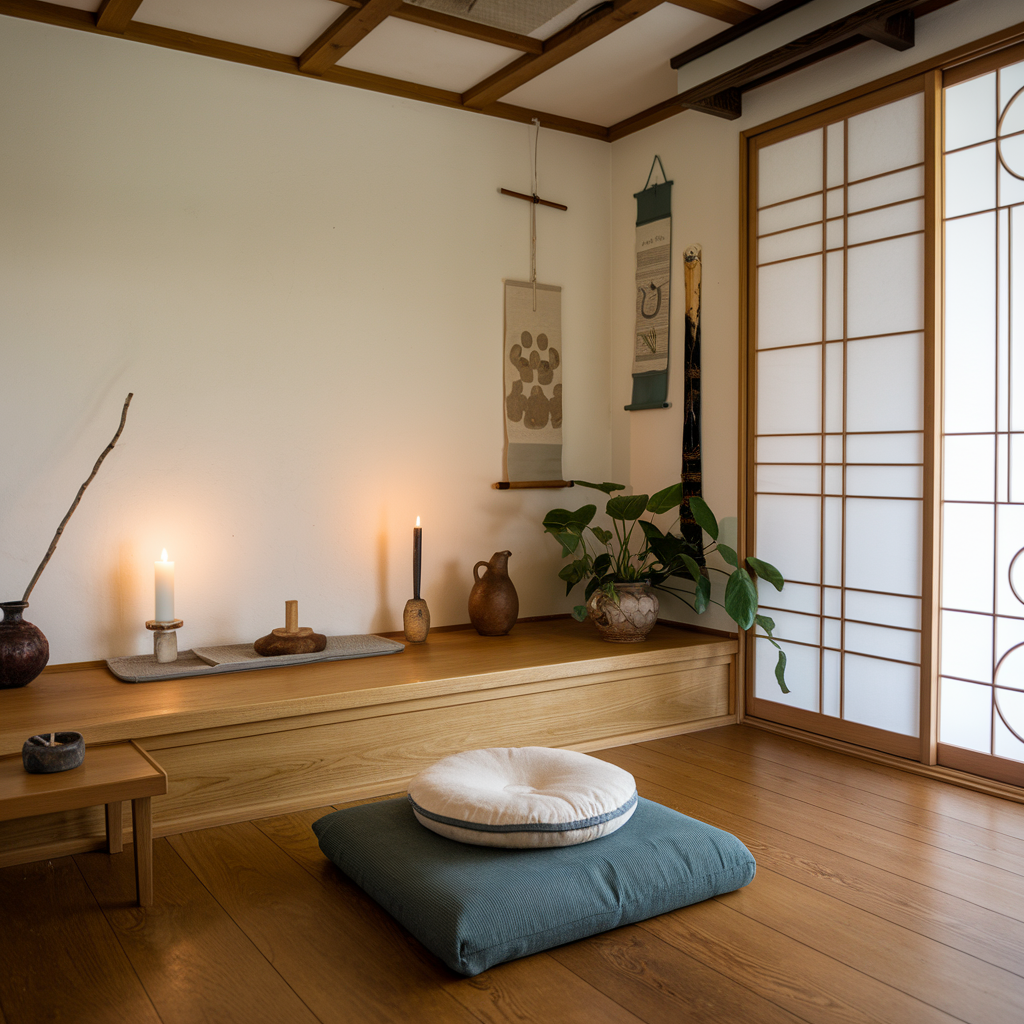
Understanding the Essence of Zen Meditation Spaces
Designing mindfulness retreats and calming atmospheres requires a deep understanding of the ancient principles of Zen design. This Japanese philosophy emphasizes the importance of creating tranquil havens that nurture the mind and soul. By delving into the psychology of peaceful environments, we can unlock the key elements that contribute to a truly meditative atmosphere.
Ancient Principles of Zen Design
The Zen approach to design is rooted in simplicity, balance, and a deep connection with nature. Practitioners of this timeless tradition believe that the physical space should serve as a canvas for mindfulness, allowing the mind to find respite from the chaos of everyday life. This involves carefully curating every element, from the placement of furniture to the choice of materials, to foster a sense of harmony and tranquility.
The Psychology of Peaceful Environments
Research has shown that the design of our surroundings can have a profound impact on our psychological well-being. Calming atmospheres, characterized by natural light, soothing sounds, and a minimalist aesthetic, have been linked to reduced stress, enhanced focus, and a deeper sense of inner peace. By understanding these principles, we can create mindfulness retreats and tranquil havens that nourish the mind and body.
Key Elements of Meditative Atmospheres
- Thoughtful lighting that promotes a sense of serenity
- Natural materials and textures that connect us to the earth
- Carefully curated décor that enhances the Zen aesthetic
- Ample space for movement and contemplation
- Harmonious color palettes that evoke feelings of calm
By incorporating these fundamental elements, we can design meditation spaces that truly embody the essence of Zen and provide a sanctuary for mindfulness and introspection.
Choosing the Perfect Location in Your Home
Creating a tranquil meditation space within your home requires careful consideration of the location. The ideal spot should offer a serene and secluded contemplative space, free from distractions and disruptions. As you explore your home, keep an eye out for quiet oases that can be transformed into rejuvenating sanctums.
When selecting the perfect spot, focus on the following factors:
- Noise levels: Choose a location away from high-traffic areas, such as the main living room or the kitchen, to minimize external sounds that could interrupt your practice.
- Natural light: Opt for a space that receives ample natural daylight, as it can have a calming and energizing effect on the senses.
- Privacy: Look for a secluded area that offers a sense of privacy, allowing you to fully immerse yourself in the meditative experience.
- Accessibility: Consider the ease of accessing your meditation space, ensuring it’s convenient to incorporate into your daily routine.
If your home doesn’t have a dedicated room for meditation, don’t worry. Get creative and explore unconventional spaces that can be transformed into contemplative oases. A quiet corner of the bedroom, a cozy nook in the living room, or even a peaceful section of the backyard can be turned into a serene meditation sanctuary.
| Ideal Location Factors | Considerations |
|---|---|
| Noise Levels | Minimize external sounds and distractions |
| Natural Light | Seek spaces with ample daylight |
| Privacy | Choose a secluded and private area |
| Accessibility | Ensure the space is convenient to access |
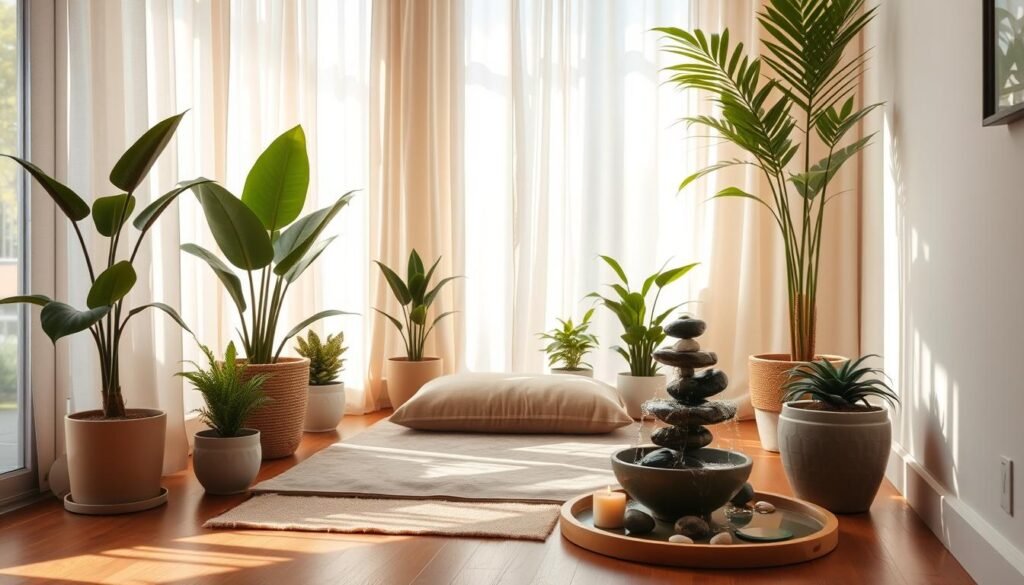
By carefully considering these factors, you can create a rejuvenating sanctuary within your home that aligns with the principles of Zen meditation and provides a serene and nurturing environment for your practice.
Essential Elements for Creating Tranquil Havens
When crafting your peaceful sanctuaries at home, it’s crucial to consider several key elements that contribute to a serene environment. From natural light to sound management and air quality, these essential components can transform your meditation spaces into true calming atmospheres.
Natural Light and Its Impact
Exposure to natural light is a vital aspect of any tranquil haven. Allowing ample sunlight to flood your meditation area can have a profound impact on your overall sense of well-being. Strategically placed windows or skylights can bring the soothing warmth and brightness of the outdoors into your serene environment, enhancing the meditative experience.
Sound Management Techniques
Effective sound management is another crucial element for creating a peaceful sanctuary. Minimizing external noise and carefully curating the soundscape within your meditation space can help cultivate a truly tranquil atmosphere. Consider incorporating sound-absorbing materials, such as soft textiles or acoustic panels, to dampen unwanted sounds and maintain a serene environment.
Air Quality and Ventilation
The quality of the air in your meditation space plays a significant role in shaping the overall serenity of the environment. Ensuring proper ventilation and maintaining clean, fresh air can contribute to a more calming and rejuvenating experience. Incorporate features like operable windows, air purifiers, or even natural plants to enhance the air quality and promote a sense of well-being.
| Element | Importance | Recommended Strategies |
|---|---|---|
| Natural Light | Enhances well-being and promotes a sense of calmness | Strategically placed windows or skylights Maximize natural light exposure Incorporate light-reflecting surfaces |
| Sound Management | Helps to create a serene and undisturbed environment | Use sound-absorbing materials Minimize external noise sources Incorporate calming background sounds |
| Air Quality and Ventilation | Contributes to a healthier and more rejuvenating atmosphere | Ensure proper ventilation Utilize air purifiers or natural plants Maintain clean and fresh air quality |
By carefully considering these essential elements, you can create peaceful sanctuaries, serene environments, and calming atmospheres that will enhance your meditation practice and provide a truly tranquil haven within your home.
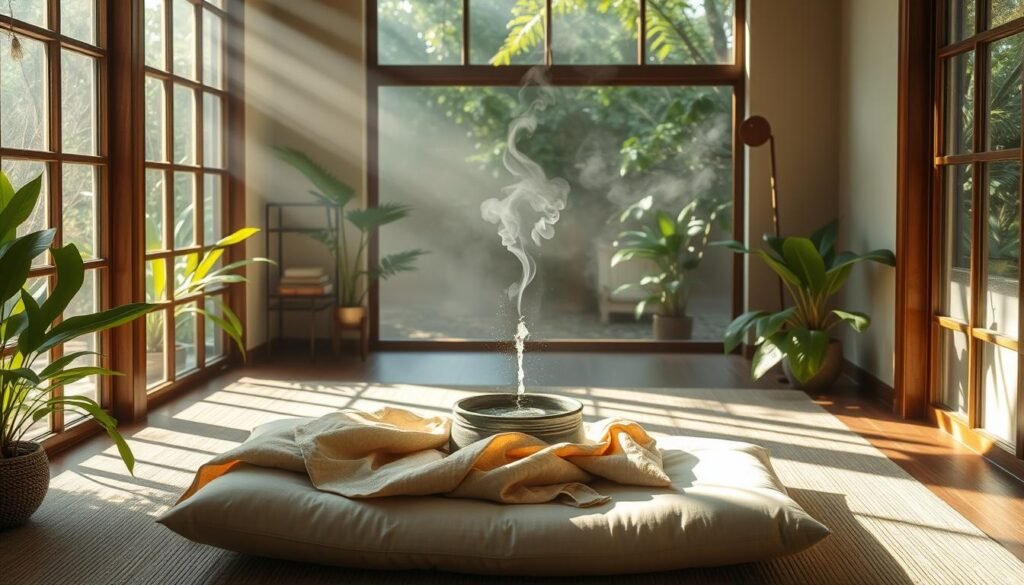
Minimalist Design Principles for Meditation Rooms
Creating a zen meditation space in your home doesn’t have to be complicated. In fact, the key to designing a truly tranquil and contemplative environment lies in embracing minimalist principles. The concept of “less is more” is central to the art of crafting soulful escapes for meditation and mindfulness practices.
At the heart of minimalist design for zen meditation spaces is the idea of decluttering and paring down to the essentials. By eliminating unnecessary distractions and visual noise, you can cultivate a space that promotes focus, clarity, and inner peace. This approach not only enhances the aesthetic appeal of the room but also supports the psychological and emotional benefits of your meditation practice.
- Choose a neutral color palette: Opt for calming shades of white, beige, or gray to create a serene and uncluttered atmosphere.
- Invest in quality, multi-purpose furniture: Select pieces that serve practical functions while maintaining a clean, streamlined look.
- Incorporate natural elements: Bring in natural materials like wood, stone, or plants to infuse the space with a sense of organic connection.
- Minimize decor and accessories: Resist the temptation to overcrowd the room with knick-knacks or ornamental pieces. Stick to a few carefully chosen, meaningful items.
- Optimize lighting: Leverage natural light as much as possible and use subtle, indirect lighting to create a warm, inviting ambiance.
By embracing these minimalist design principles, you can transform your home into a contemplative space that inspires deep reflection and nourishes your zen meditation practice. Simplicity is the ultimate sophistication when it comes to creating the perfect soulful escape for your personal well-being.
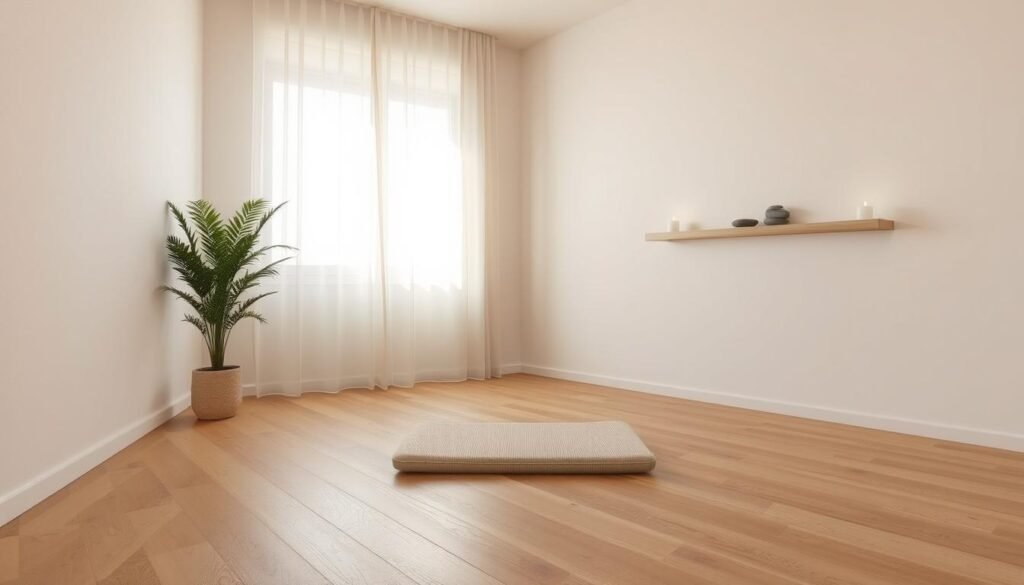
“The true essence of a thing is not the object itself, but the space within it and around it.” – Lao Tzu
Selecting the Right Colors for Your Peaceful Sanctuary
Creating a peaceful sanctuary at home is not just about the physical arrangement of space – the colors you choose can also play a significant role in cultivating calming atmospheres and tranquil havens. By understanding the psychology of color and embracing traditional Zen color palettes, you can design meditation spaces that truly nourish the senses and support your mindfulness practice.
Color Psychology in Meditation
Colors have a profound impact on our mood, emotions, and mental state. In the context of meditation, certain hues can promote relaxation, focus, and introspection. For instance, shades of blue are known to induce a sense of calmness and serenity, while earthy tones like greens and browns can help ground and center the mind. Exploring the psychological effects of color can guide you in selecting the most appropriate palette for your peaceful sanctuaries.
Traditional Zen Color Palettes
- Neutral tones: Shades of white, beige, and gray are quintessential Zen colors, reflecting the philosophy of simplicity and minimalism.
- Muted tones: Soft, muted hues like light blues, greens, and lavenders create a soothing and contemplative atmosphere.
- Natural tones: Drawing inspiration from the earth, wood, and stone, earthy tones such as browns, tans, and ochres can ground the space and enhance the connection with nature.
By incorporating these traditional Zen color palettes into your meditation spaces, you can cultivate a sense of tranquility and balance that is essential for deep, meaningful practice.
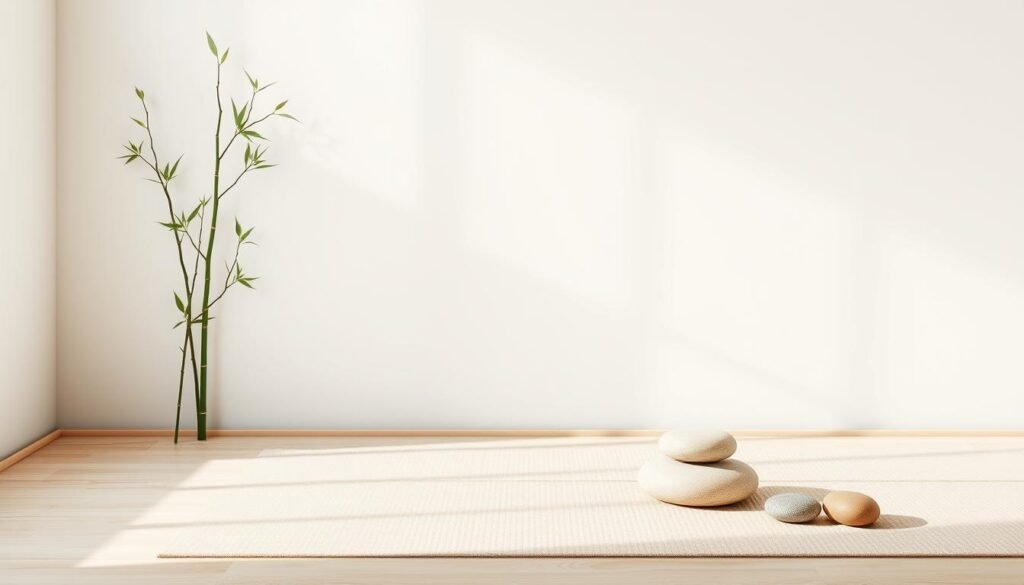
| Color | Psychological Effect | Suggested Use |
|---|---|---|
| Blue | Calming, serene, introspective | Walls, textiles, accents |
| Green | Grounding, harmonious, natural | Decor, furniture, plantlife |
| White | Purity, simplicity, clarity | Walls, ceilings, linens |
| Brown | Earthy, stable, grounding | Flooring, furniture, accents |
“The true beauty of a space is not in its lavish decorations, but in the tranquility it evokes within the mind.” – Zen Master Thich Nhat Hanh
Incorporating Natural Elements and Materials
When creating a serene and rejuvenating mindfulness retreat at home, the integration of natural elements and materials is crucial. These organic touches can help establish a strong connection with the environment, fostering a sense of tranquility and balance that is essential for effective meditation practices.
One of the most popular natural materials for zen meditation spaces is wood. From warm, earthy tones to intricate grains, wooden accents can instantly imbue a space with a calming, grounded ambiance. Whether it’s a wooden meditation bench, a floating shelf, or a simple side table, these natural elements can instantly elevate the serenity of the environment.
Similarly, the incorporation of stone features, such as a small water fountain or a smooth river rock display, can create a soothing, meditative focal point. The ancient principles of zen design often emphasize the use of these raw, natural materials to cultivate a sense of balance and harmony.
- Strategically placed plants can also enhance the serene environments of mindfulness retreats. Lush greenery and the gentle movement of leaves can have a profoundly calming effect, helping to purify the air and promote a deeper state of relaxation.
- The gentle sound of flowing water from a tabletop fountain or a small indoor pond can also contribute to the overall sensory experience, masking distracting noises and encouraging deeper focus during meditation.
By thoughtfully incorporating these natural elements and materials, you can transform your living space into a true rejuvenating sanctum – a haven where the boundaries between the indoors and the outdoors blur, allowing you to fully immerse yourself in the tranquil essence of zen meditation.
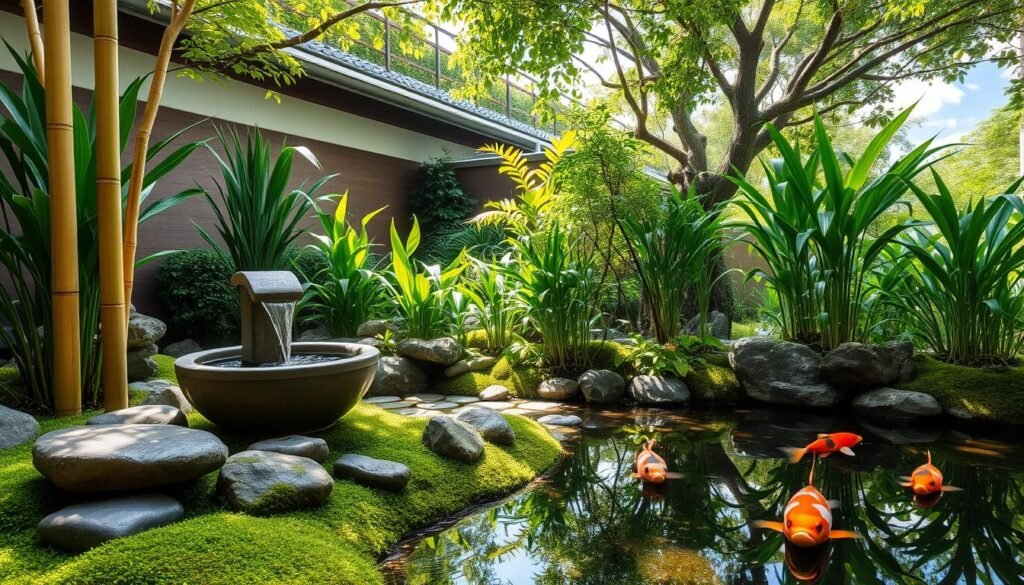
| Natural Material | Benefits for Zen Meditation Spaces |
|---|---|
| Wood | Warm, grounded ambiance; Organic textures and tones |
| Stone | Soothing focal points; Adherence to zen design principles |
| Plants | Calming greenery; Air purification; Sensory experience |
| Water | Gentle, soothing sounds; Promotion of relaxation and focus |
“The true essence of a zen meditation space lies in its ability to seamlessly blend the natural world with the indoor environment, creating a serene and rejuvenating sanctuary for the mind and soul.”
Lighting Solutions for Contemplative Spaces
Creating the perfect ambiance for your zen meditation spaces is crucial for cultivating a sense of peace and tranquility. When it comes to lighting, the interplay between natural and artificial light can have a profound impact on the overall atmosphere. Let’s explore the nuances of lighting solutions that can transform your contemplative spaces into true peaceful sanctuaries.
Natural vs. Artificial Light
Natural light, with its soft, soothing qualities, can have a profoundly calming effect on the mind. Allowing ample daylight to flood your soulful escapes can help you feel more connected to the natural rhythms of the world around you. However, relying solely on natural light may not always be practical, especially during the evenings or on overcast days. This is where carefully selected artificial lighting can complement and enhance the meditative experience.
Mood-Enhancing Lighting Options
- Dimmable fixtures: Adjustable lighting allows you to control the intensity and create the perfect ambiance for your meditation practice.
- Salt lamps: The warm, gentle glow of salt lamps can instill a sense of tranquility and promote relaxation.
- Candles: Flickering candles can add a touch of coziness and warmth to your contemplative spaces, creating a soothing and introspective atmosphere.
By incorporating a balance of natural and artificial lighting solutions, you can craft peaceful sanctuaries that cater to your unique meditative needs, allowing you to fully immerse yourself in the present moment and experience the profound benefits of zen meditation.
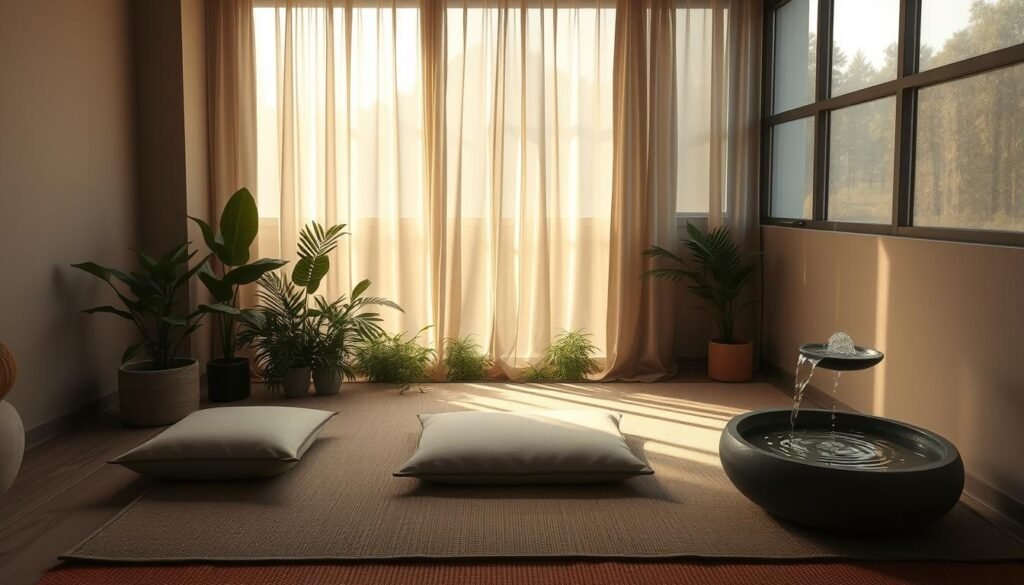
“The true essence of a zen meditation space lies in the thoughtful interplay of light, creating an environment that soothes the senses and nourishes the soul.”
Essential Furniture and Accessories for Zen Meditation Spaces
Creating the perfect zen meditation space at home goes beyond just the overall design and ambiance. Carefully selecting the right furniture and accessories can significantly enhance the tranquility and functionality of your personal oasis. From comfortable meditation cushions to minimalist storage solutions, each element plays a crucial role in cultivating a mindful retreat within your living space.
At the heart of any zen meditation space are the seating options. Invest in high-quality meditation cushions that provide the necessary support and elevation for proper posture during your practice. Look for cushions filled with natural materials like buckwheat or cotton to ensure optimal comfort and breathability. Pair the cushions with sleek, low-profile meditation mats that help define your personal practice area.
Complement the seating with a minimalist low table or stand to hold any necessary items, such as incense, candles, or a small potted plant. Opt for natural wood or bamboo finishes to maintain the zen aesthetic. Thoughtful storage solutions, like hidden shelves or cabinets, can help maintain the clean, uncluttered look essential for peaceful meditation spaces.
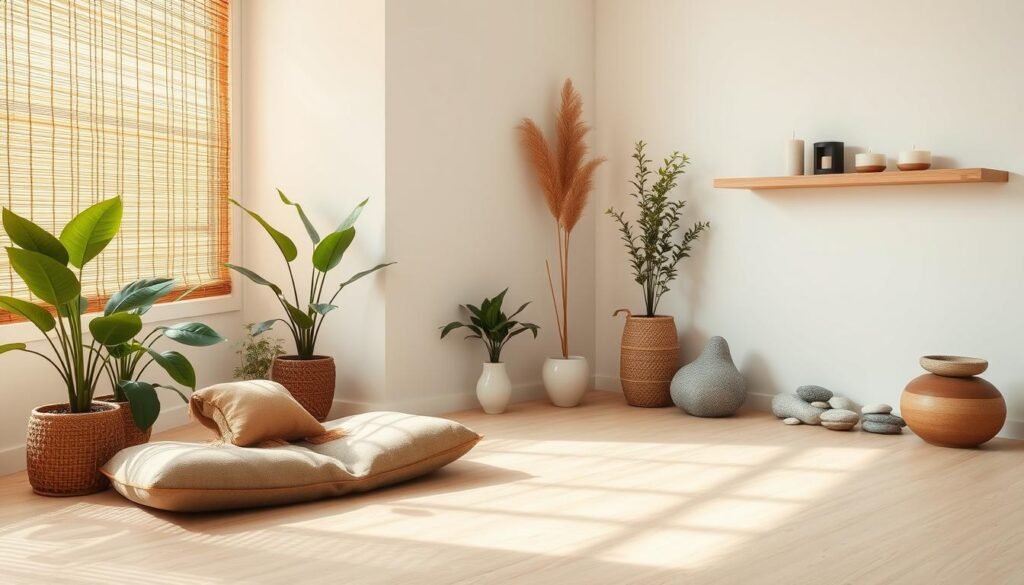
Ultimately, the key to curating the perfect zen meditation space is to choose furniture and accessories that seamlessly blend functionality and minimalist design. By carefully selecting each element, you can create a truly restorative and visually calming oasis within your home – a quiet haven for your mindfulness retreats.
Creating a Sensory-Balanced Environment
Within the peaceful sanctuaries of your zen meditation spaces, engaging the senses can profoundly enhance the overall experience. By incorporating the aromatic essences of nature, you can elevate your practice and create a truly soulful escape.
Aromatherapy and Incense
The strategic use of essential oils and natural incense can transform your tranquil haven into a sensory delight. Experiment with calming scents like lavender, frankincense, or sandalwood to promote relaxation and focus during your meditation sessions. Allow the gentle wisps of fragrance to gently envelope the space, guiding your mind towards a state of serenity.
Texture and Touch Elements
Incorporating a variety of textures and touch elements can further enrich the sensory experience of your zen meditation spaces. Consider incorporating soft, natural fabrics like organic cotton or linen for your seating and accents. Complement these with the warmth of wood, the coolness of stone, or the smoothness of bamboo to engage the sense of touch and create a truly tactile sanctuary.

Hello, I’m Jane, founder of Home Vibe Ideas. I’m here to inspire stylish Home Design, modern Smart Living, beautiful Outdoor Spaces, and creative DIY Projects to help you create a home that’s uniquely yours.
Disclosure: This post contains affiliate links. If you click on a link and make a purchase, we may earn a small commission at no additional cost to you. The content on this site was created with the help of AI technology.


